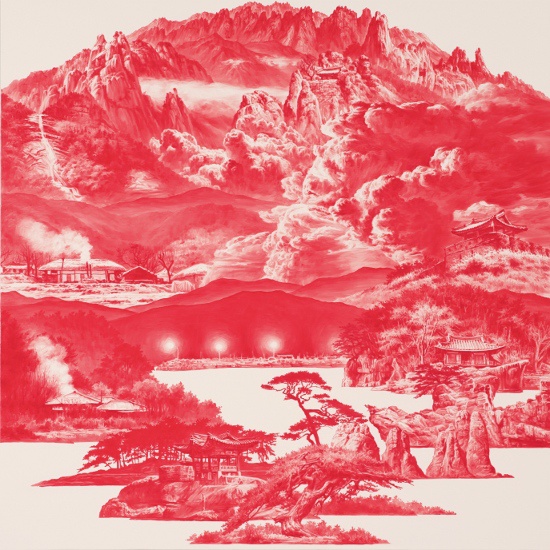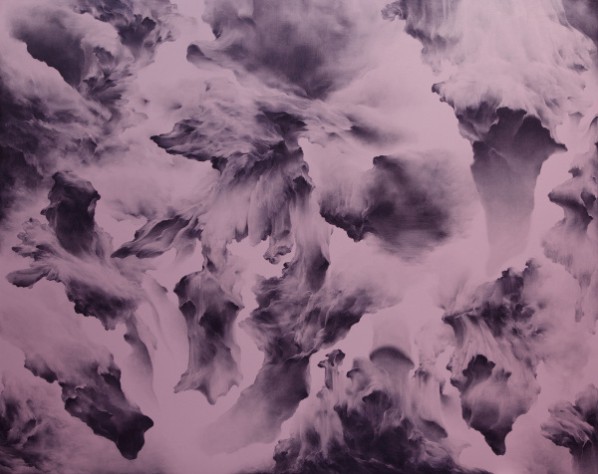
Lee Sea Hyun, Between Red-015SEP02, 2015; Oil on linen, 100x100cm
Pearl Lam Galleries is pleased to present Contemporary Sansuhwa , a group exhibition introducing contemporary Korean landscape painting and showcasing works by three prominent Korean artists: Lee Sea Hyun (b. 1967), Moon Beom (b. 1955), and Whang Inkie (b. 1951), curated by Miki Wick-Kim, curator, writer, and art advisor based in Zurich, Switzerland.
Sansuhwa is the Korean word for ‘landscape painting’, with the word san meaning ‘mountain’ and su ‘water’. As elsewhere in East Asia, landscape painting was one of the preeminent genres of traditional fine arts in Korea. Much of the country’s landmass is mountainous, and the cultural traditions and philosophies, including Taoism, Buddhism and Confucianism, have been informed in part by a relationship to the mountains and nature. Landscape paintings were seldom only representational, but were explorations by classical artists in search of an ideal land or paradise.The works of many contemporary Korean artists are informed by this inherited legacy of landscape painting. Although they recognise the intrinsic cultural tradition they share and their connection with nature, they opt to distinguish their output with an expansive range of individual expressions. This exhibition presents the works of three artists who represent contemporary landscape painting from very diverse points of view. As their works embrace new inspirations, themes, and processes, they give rejuvenated relevance to this traditional form. Moreover, they are not necessarily interested in nor value the promise of an ideal world, as their concerns are very much anchored in contemporary reality.

Moon Beom, Secret Garden #309, 2012; Acrylic and oil stick on canvas, 182x228cm
Lee Sea Hyun’s red-on-white landscape paintings are a complex layering of multiple references and motifs far from the classical landscape notions of the ideal; rather, they are a collision of his memories of a now disappearing natural world with a critical reflection on Korea’s contemporary sociopolitical panorama. Laboriously rendered in exquisite detail and rich tonality, Lee’s paintings longingly recall the vistas from his childhood on Geoje Island, off Korea’s southern coast, where the views of beaches, mountains, natural harbours, and far-off temples have been altered by urban development. Lee’s fragmented landscapes weave together historical references, trauma, and the conflicts present within a rapidly modernised South Korea. Through his exclusive use of red and the juxtaposition of various symbolic and contradictory references, as if a work of collage, Lee lends the works an uncanny tension and mystery.
Moon Beom is one of the successor generation of artists to emerge from the Korean modernist movement, exemplified by Monochrome art of the 1970s. This movement engaged with Eastern spirituality, its meditations on the natural world, and the notion of a harmonious universal oneness. Moon’s paintings are the expression of a contemporary language articulating concepts born of such traditional points of view. His reduced and abstract forms reference mountains, waterfalls, clouds, and foliage, and yet they reflect philosophical concepts more than representational elements. Thus, the interstitial spaces between the forms also contain meaning, expressing a spiritual notion of the void. Moon begins his paintings by preparing a flat area of acrylic on canvas or panel. He then works this flat background colour with oil stick. Preferring the immediacy of a direct encounter with the material, Moon does not paint with a brush, instead applying the oil stick by smudging the colour with his fingers, for which he wears a cotton glove. The slow and flowing gestural application of the oil stick creates the resplendent tonality, the sensuality, and the emotional
depth characteristic of his work.

Whang Inkie, An Old Breeze-Mt. Diamond, 2015; Swarovski synthetic crystal & acrylic paint on canvas, 200x144x6cm
Materiality is fundamental to Whang Inkie’s practice in which he constructs works merging Eastern tradition with contemporary technology. Inspired by canonical Korean and Chinese landscape paintings by classical painters, Whang begins by scanning reproductions of the images. He takes advantage of the resulting pixilation to realise laboriously crafted works in diverse materials, such as small-scale Lego pieces, silicon droplets, and crystals, in a process that the artist describes as ‘digital sansuhwa’. In his work An Old Breeze–Mt. Diamond , 2015, Whang adapts Korean master painter Jeong Seon’s (1676–1759) treasured Scene of Diamond Mountain with thousands of tiny crystal pieces attached to the acrylic-on-canvas surface. The re-contextualising of the appropriated image produces a dazzling and semi-abstract work that reflects the hybrid position of many contemporary Korean artists at the intersection of deep-rooted traditions, hypermodernity, and individual experimentation. The viewer might even feel compelled to step into a shimmering landscape of centuries past and dream of an ideal world quite far removed from mortal concerns.
“We are very excited to be presenting another strongly curated exhibition at Pearl Lam Galleries Hong Kong. Contemporary Sansuhwa is the first Korean artist group show that explores Korean contemporary art by three dynamic artists with unique views of and approaches to landscape painting.”—Pearl Lam, Founder of Pearl Lam Galleries
About Lee Sea Hyun
Lee Sea Hyun (b. 1967, Geoje Island, South Korea) received his Bachelor of Fine Arts and Master of Fine Arts from Hongik Universtiy, Seoul, and a Master of Fine Arts from Chelsea College of Art and Design, London. He has exhibited extensively worldwide, including the solo exhibitions Red-Silly Dream , Mimesis Art Museum, Paju City, South Korea, 2015; Plastic Garden , Hakojae Gallery, Seoul, 2012; Between Red , Nicholas Robinson Gallery, New York, 2011; and Between Red , Miki Wick Kim Contemporary Art, Zurich, Switzerland, 2007. His works can be found in prestigious collections, which include the Uli Sigg Collection, Lucerne, Switzerland and Hong Kong; Burger Collection, Zurich, Switzerland and Hong Kong; and the Seoul Museum of Art. Lee lives and works in Seoul, South Korea.
About Moon Beom
Moon Beom (b. 1955, Seoul, South Korea) received his Bachelor of Fine Arts and Master of Fine Arts from Seoul National University. He has exhibited extensively worldwide, including Korean Eye, Saatchi Gallery, London, 2012; Hidden Tracks , Seoul Museum of Art, Seoul, 2012; and Dansaekhwa—Korean Monochrome Painting , National Museum of Contemporary Art, Seoul, 2012. Solo exhibitions include at Kim Foster Gallery, New York in 2013 and PKM Gallery, Seoul in 2007. His works can be found in prestigious collections, including the National Museum of Contemporary Art, Seoul; Leeum Samsung Museum of Art, Seoul; Seoul City Museum of Art; and the UBS Art Collection, Zurich, Switzerland. Moon lives and works in Seoul, South Korea and is a professor at Konkuk University.
About Whang Inkie
Whang Inkie (b. 1951, Chungcheong, South Korea) received his Bachelor of Fine Arts in painting from Seoul National University and Master of Fine Arts from Pratt Institute, New York. He has exhibited extensively worldwide, including solo exhibitions at Savina Museum of Contemporary Art, Seoul, 2014; Arko Art Center, Seoul, 2011; Frey Norris Gallery, San Francisco, 2007; and the Atlanta College of Art Gallery, 2004. He represented South Korea along with two other artists at the 50th Venice Biennale in 2003 with the exhibition Landscape of Differences . He was also nominated for Artist of the Year in 1997 by the National Museum of Contemporary Art, Gwacheon, South Korea. His works can be found in prestigious collections, including the Metropolitan Museum of Art, New York; the National Museum of Contemporary Art, Seoul; and Leeum Samsung Museum of Art, Seoul. Whang lives and works in Okcheon, South Korea and is a professor at Sungkyunkwan University.
About Miki Wick-Kim
Miki Wick-Kim was born in Seoul, South Korea. She is a curator, writer, and art advisor based in Zurich, Switzerland. Wick-Kim received her Diploma in Graphic Arts from Royal Melbourne
Institute of Technology in Australia and a Bachelor of Fine Arts from Pratt Institute, New York. She founded Miki Wick Kim Contemporary Art in 2006, which operated as a gallery until 2011,
and continues in an advisory capacity. She is a recognised expert on Korean contemporary art, and her eponymous book on the subject was published by Prestel in 2012. She has previously
worked with other notable galleries and institutions, including as a director of Galerie Edwynn Houk, a leading New York and Zurich based gallery specialising in vintage photography (1917–
39) by modernist masters as well as contemporary photographers.
About Pearl Lam Galleries
Founded by Pearl Lam, Pearl Lam Galleries is a driving force within Asia's contemporary art scene. With over 20 years of experience exhibiting Asian and Western art and design, it is one
of the leading and most established contemporary art galleries to be launched out of China.
Playing a vital role in stimulating international dialogue on Chinese and Asian contemporary art, the Galleries is dedicated to championing artists who re-evaluate and challenge perceptions of cultural practice from the region. The Galleries in Hong Kong, Shanghai, and Singapore collaborate with renowned curators, each presenting distinct programming from major solo exhibitions, special projects, and installations to conceptually rigorous group shows. Based on the philosophy of Chinese Literati where art forms have no hierarchy, Pearl Lam Galleries is dedicated to breaking down boundaries between different disciplines, with a unique gallery model committed to encouraging cross-cultural exchange.
Contemporary Chinese Abstract art is heavily represented in the Galleries roster. Influential Chinese artists Zhu Jinshi and Su Xiaobai, who synthesise Chinese sensibilities with an international visual language, are presented internationally with work now included in major private and public collections worldwide. The Galleries has also introduced leading international artists such as Leonardo Drew, Jenny Holzer, Carlos Rolón/Dzine and Yinka Shonibare MBE to markets in the region, providing opportunities for new audiences in Asia to encounter their work. Pearl Lam Galleries encourages international artists to create new work which engages specifically with the region, collaborating to produce thought-provoking, culturally relevant work.
About the exhibition
Date: 15 January–1 March, 2016
Venue: Pearl Lam Galleries, 6/F, Pedder Building, 12 Pedder Street, Central, Hong Kong
Courtesy of the artists and Pearl Lam Galleries, for further information please visit www.pearllam.com.




























